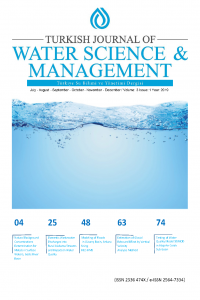Abstract
References
- Reference1 Aydin, S., Kucuksezgin, F. (2012). Distribution and chemical speciation of heavy metals in the surficial sediments of the Bakırçay and Gediz Rivers, Eastern Aegean, Environmental Earth Sciences, 65, 3, 789–803. Reference2 Bizsel, N., Ardelan, M. V., Bizsel, K. C.Suzal, A. Demirdag, A., Sarıca, D.Y. (2017). Distribution of selenium in the plume of the Gediz River, Izmir Bay, Aegean Sea, Journal of Marine Research, 75,2, 81-98. Reference3 Directive, EQS (2008). Guidelines for the identification of Mixing zones on environmental quality standards in the field of water policy, amending and subsequently repealing Council Directives 82/176. EEC, 83, 513. Reference4 Dutch 4th National Water Plan, 1998, Ministry of Infrastructure and the Environment Ministry of Economic Affairs, Netherlands. Reference5 EC, 2011. Common Implementation Strategy for the Water Framework Guidance Document No. 27, Technical Guidance for Driving Environmental Quality Standards, European Commission. Reference6 Kucuksezgin, F., Uluturhan, E.,Batki, H. (2008). Distribution of heavy metals in water, particulate matter and sediments of Gediz River (Eastern Aegean), Environmental Monitoring and Assessment, 141,1–3,213–225. Reference7 MoFWA (2015). Project of Determination of Sensitive Areas and Water Quality Objectives in Turkey, Ministry of Forestry and Water Affairs, General Directorate for Water Management (Prepared by TUBITAK Marmara Research Center). Reference8 Osté, L.A., Klein, J. Zwolsman, G.J. (2011). Inventory and evaluation of methods to derive natural background concentrations of trace metals in surface water, and application of two methods in a case study. Deltares report, Utrecht. Reference9 Peters, P., Merrington, G., Crane, M. (2010). Estimation of background reference concentrations for metals in UK freshwaters. Environment Agency, Final report, Edinburgh. Reference10 SHW, 2016. State Hydraulic Works 2nd Regional Directorate (2016). Gediz Basin Groundwater Planning-Hydrogeological Survey Implementation Main Report (in Turkish). Reference11 Suzer, E.U., Kontaş, A.,Yılmaz,E.C. (2015). Gediz Deltası dalyan alanlarının (İzmir Körfezi) yüzey sedimentlerinde ağır metal kirliliğinin değerlendirilmesi, Ege Journal of Fisheries and Aquatic Sciences, 32(2): 79-87 (in Turkish). Reference12 Turkish By-law on Surface Water Quality, OG: 30.11.2012/28483, Ministry of Forestry and Water Affairs. Reference13 WFD, 2000. The European Water Framework Directive, 2000/60/EC. Reference14 Zuurdeeg, B.W., Van Enk, R.J., Vriend, S.P. (1992). Natuurlijke Achtergrond gehalten van zware metalen en enkele andere sporenelementen in Nederlands oppervlaktewater. Geochem-Research, Utrecht (in Dutch).
Abstract
In this study, an approach was developed for natural background concentration determination of metals and metalloids (Ag, Al, As, B, Co, Cr, Cu, Fe, Sb, Sn, V, Zn, Ti, Cd, Ni, Pb and Hg) listed in By-law on Surface Water Quality (OG: 30.11.2012/28483) as priority substances or specific pollutants. Gediz River Basin was selected as a pilot area and seasonal monitoring studies were conducted in the selected surface waters during 2015-2016. For determination of NBC, it is necessary to distinguish whether the presence of metals detected in the receiving environment is natural or anthropogenic. In this context, anthropogenic sources were monitored and evaluated according to the pollution contribution of each pressure; natural sources of investigated metals were considered according to mining activities and geothermal source distribution. A methodology was developed and applied by indicating the relative contribution of pollutant resources and whether critic value was exceeded or not. Pollution contribution was calculated representing the relative effect of anthropogenic sources. This approach was found suitable for determining NBC and could be helpful for decision makers by establishing critical factors (e.g. which facility should be established where; which plant can discharge its pollutant in which amount; what kind of precautions should be taken in agricultural activities; as well as how to reduce the pesticides used) while comparing the effect of pollution sources.
Keywords
Metals surface waters water quality natural background concentration environmental quality standards.
References
- Reference1 Aydin, S., Kucuksezgin, F. (2012). Distribution and chemical speciation of heavy metals in the surficial sediments of the Bakırçay and Gediz Rivers, Eastern Aegean, Environmental Earth Sciences, 65, 3, 789–803. Reference2 Bizsel, N., Ardelan, M. V., Bizsel, K. C.Suzal, A. Demirdag, A., Sarıca, D.Y. (2017). Distribution of selenium in the plume of the Gediz River, Izmir Bay, Aegean Sea, Journal of Marine Research, 75,2, 81-98. Reference3 Directive, EQS (2008). Guidelines for the identification of Mixing zones on environmental quality standards in the field of water policy, amending and subsequently repealing Council Directives 82/176. EEC, 83, 513. Reference4 Dutch 4th National Water Plan, 1998, Ministry of Infrastructure and the Environment Ministry of Economic Affairs, Netherlands. Reference5 EC, 2011. Common Implementation Strategy for the Water Framework Guidance Document No. 27, Technical Guidance for Driving Environmental Quality Standards, European Commission. Reference6 Kucuksezgin, F., Uluturhan, E.,Batki, H. (2008). Distribution of heavy metals in water, particulate matter and sediments of Gediz River (Eastern Aegean), Environmental Monitoring and Assessment, 141,1–3,213–225. Reference7 MoFWA (2015). Project of Determination of Sensitive Areas and Water Quality Objectives in Turkey, Ministry of Forestry and Water Affairs, General Directorate for Water Management (Prepared by TUBITAK Marmara Research Center). Reference8 Osté, L.A., Klein, J. Zwolsman, G.J. (2011). Inventory and evaluation of methods to derive natural background concentrations of trace metals in surface water, and application of two methods in a case study. Deltares report, Utrecht. Reference9 Peters, P., Merrington, G., Crane, M. (2010). Estimation of background reference concentrations for metals in UK freshwaters. Environment Agency, Final report, Edinburgh. Reference10 SHW, 2016. State Hydraulic Works 2nd Regional Directorate (2016). Gediz Basin Groundwater Planning-Hydrogeological Survey Implementation Main Report (in Turkish). Reference11 Suzer, E.U., Kontaş, A.,Yılmaz,E.C. (2015). Gediz Deltası dalyan alanlarının (İzmir Körfezi) yüzey sedimentlerinde ağır metal kirliliğinin değerlendirilmesi, Ege Journal of Fisheries and Aquatic Sciences, 32(2): 79-87 (in Turkish). Reference12 Turkish By-law on Surface Water Quality, OG: 30.11.2012/28483, Ministry of Forestry and Water Affairs. Reference13 WFD, 2000. The European Water Framework Directive, 2000/60/EC. Reference14 Zuurdeeg, B.W., Van Enk, R.J., Vriend, S.P. (1992). Natuurlijke Achtergrond gehalten van zware metalen en enkele andere sporenelementen in Nederlands oppervlaktewater. Geochem-Research, Utrecht (in Dutch).
Details
| Primary Language | English |
|---|---|
| Journal Section | TURKISH JOURNAL OF WATER SCIENCES AND MANAGEMENT |
| Authors | |
| Publication Date | January 14, 2019 |
| Published in Issue | Year 2019 Volume: 3 Issue: 1 |


